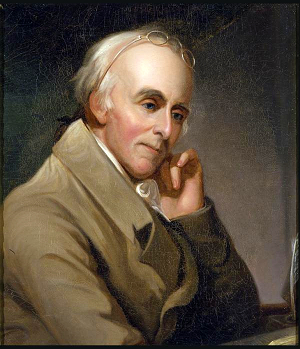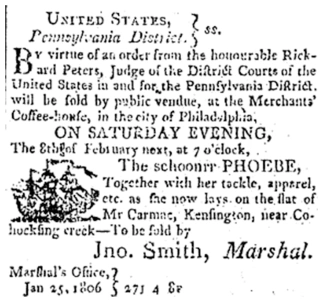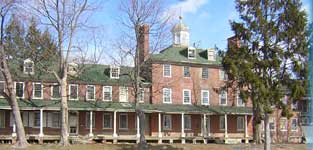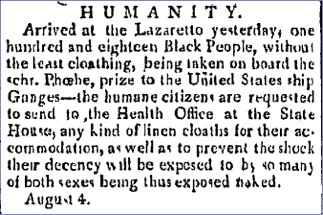The Ganges Africans who were held at the Lazaretto station (Tinicum) in 1800.
by Dona Horowitz-Behrend Ph.D., Public Historian
May 24, 2007
Permission to print granted to ushistory.org by Philadelphia Department of Records
See also: Philadelphia and the Slave Trade: The Ganges Africans
The Philadelphia Almshouse, established in 1729, was the first institution in the American Colonies to provide hospitalized care for the poor. In 1794, the city established a health office that was one of the first in the nation. It also created the Municipal Hospital for Contagious Diseases and a quarantine hospital for the Port of Philadelphia called the Lazaretto. Twenty-four health inspectors managed all. In 1804, their control was placed under an independent Board of Health also charged with removing all nuisances prejudicial to public health.

Dr Benjamin Rush
Charles Wilson Peale ca 1818
In the summer of 1793, Philadelphia was struck by a yellow fever epidemic that killed 1/10 of the city's population (almost 5,000) persons) in less than five months. It is considered one of the worst epidemics to ever hit an American city. Over one-third of the inhabitants fled the city leaving only a courageous few behind. Dr. Benjamin Rush, one of Philadelphia's most prominent physicians, was one of them. Rush served on a temporary Board of Health established to enforce sanitary regulations. The Board worked with the Guardians of the Poor to set up a hospital beyond the city limits to quarantine the victims — the Lazaretto was established in 1794. The plague returned the following summers, taking the lives of 3,500 in 1797.
During the epidemic Philadelphia Mayor Matthew Clarkson asked for additional volunteers to help with the care of the sick. Two of the few that stepped forward were African-American clergymen Richard Allen and Absalom Jones. Most of the 2,500 African-Americans living in the city were free. Allen and Jones recruited volunteers through the Free African Society to bring the sick to the quarantine hospital, serve as nurses in the infected areas and help bury the dead. At the time of the epidemic many believed blacks were immune to it. In the end, they were proved wrong as more than 300 African-Americans perished.
By law the Lazaretto was also the first stop for vessels entering the Port of Philadelphia. The ship's captain had to provide a complete crew and passenger list including any sickness. Ships were detained for thirty days until quarantine staff was satisfied disease was not on-board.

Auction notice for the captured slave ship Phebe
During the summer of 1800, the naval ship USS Ganges captured two illegal U.S. slave ships, schooners Phebe and Prudent, off the coast of Cuba. The ships were considered prizes. They were brought to the Port of Philadelphia because of the city's strong anti-slavery sentiments. The Africans on board were not returned to their native land. They were detained at the Lazaretto for 31 days until their legal status established. During their stay the emaciated and diseased slaves were nursed back to health by the staff of the Lazaretto.
According to the account ledger of when ships arrived, the Schooner Phebe — Prize to Ganges was rendered August 17, 1800, rather than August 22nd, as reported in the Ship Manifests, 1800-1840 Port of Philadelphia, microfilm, PA State Archives, Harrisburg, PA.. Dr. Doll Bent conducted the inspection. The entire entry reads:
August 17th, 1800 Rendered
Schooner Phebe, _____Prize to Ganges Dr. Doll bent
To Daniel McDonald board: r. 6 days d. by — -4.02.
Board of Health: Marine Hospital Accounts
Lazaretto Hospital, 1794-1800
Nursing and burial accounts of crew at hospital.
City of Philadelphia Archives
H. 78.1
A second entry in the same ledger lists the date, number of Africans treated from the Schooners Phebe and Prudent, and expense. They were treated at the Lazaretto Hospital from August 9, 1800 until October 31st thus placing both Schooners in Port by August 9, 1800. The ledger indicates that six Africans died, and 172 (37 needed care more than once because both ships contained a total of 135 Africans) needed medical attention. The majority needed nursing and medical attention one or two days, but two Africans needed medical attention for 46 days.
The ledger entry is as follows:
All "Rendered".
Dr. John Hall Esqr. Marshall of the District of Pennsylvania
| 1800 | To the boarding nursing and medical attendance of Sundry Africans, landed from the Schooners Phebe and Prudent, taken by the Ganges viz Doll Cents. |
| Aug. 9 | To 10 Africans board: r. | 4 days each, d., by Cents | 26.80 |
| | Coffin and burying | 1 African | 4. |
| 10 | 9 Africans board: r. 1 day each, by | 6.03 |
| 11 | 12 (de) ibid. | | 8.04 |
| 13 | 14 ibid | 2 day | 18.76 |
| 15 | 10 ibid | 2 day | 13.40 |
| 16 | 10 ibid | 1 day | 6.70 |
| 17 | 11 ibid | 1 day | 7.37 |
| 19 | 8 ibid | 2 day | 10.72 |
| 20 | 8 ibid | 1 day | 5.36 |
| 21 | 11 ibid | 1 day | 7.37 |
| | Coffin and burying | 1 African | 4. |
| 23 | 11 Africans board: r. 2 days each, out by 6th | 14.74 |
| 25 | 12 ibid | 2 ibid | 16.08 |
| | Coffin and burying | 1 African | 4. |
| 27 | 10 Africans board: r. 2 days each, out by 6th | 13.40 |
| 29 | 10 Africans ibid. | 2 days | 13.40 |
| | Coffin and burying | 1 African | 4. |
| 30 | 9 Africans board: r. 1 day each, out by 6th | 6.03 |
| Sept 2 | 7 ibid | 3 ibid | 14.07 |
| 8 | 7 ibid | 6 ibid | 28.14 |
| 8 | Coffin and burying | 1 African | 4. |
| 10 | 3 Africans board: r. 2 days each, out by | 4.02 |
| | 35 Qts.1pt.4h pt. Wine | , 50 | 17.87 |
| | 18 Qts. Rum | , 50 | 9. |
| 15 | 3 Africans board: r. 5 days each, d. by | 10.05 |
| | Coffin and burying | 1 African | 4. |
| Oct. 31 | 2 Africans board: r. 46 days each, d. by | 61.64 |
| | 61 half pints wine | ,15 | 9.15 |
| Amount Dollars | 352,147 |
Board of Health: Marine Hospital Accounts
Lazaretto Hospital, 1794-1800
Nursing and burial accounts of crew at hospital.
City of Philadelphia Archives
H. 78.1
The care the Africans received at the Lazaretto was excellent. Only one was admitted to the Alms House from City Hospital as evidenced from the Guardians of the Poor Daily Occurrences, January 1800 — September 1801. The entry reads:
Wednesday October 29th, 1800
Admitt: Negro Ganges was brought here from the City Hospital, and for whose board the John Hall, [Marshall] engages to pay as James Poultney's Order that see on file. Dr.city.
Guardians of the Poor
Daily Occurrences
Jan 1800 — September 1801
City of Philadelphia Archives
GP 69
The Abolition Society of Philadelphia took guardianship of the Africans and dispersed them into American society via indentures, most eventually became part of the Philadelphia population of free blacks. The process took many months and the 135 enslaved persons were the subject of a mass appeal for blankets and clothing throughout southeastern Pennsylvania to protect from the coming harsh weather.
The ships arrived August 22, 1800 [Actually on August 9, 1800 according to the ledger entry from the Marine Hospital Accounts, 1794-1800]. Schooner Phoebe (Prize to Ship Ganges) Calvin Stevens Prize Master. Cargo-Africa-bound for Philadelphia 118 African men, women and children. Schooner Prudent (Prize to Ship Ganges) W.M. Robbins, Prize Master. (17 Africans, men, women and children.) Source: Ship Manifests, 1800-1840 Port of Philadelphia, microfilm, PA State Archives, Harrisburg, PA.
Already in place in Philadelphia was The Guardians of the Orphan Children, created in 1794 specifically to care for the orphaned children of the victims of the yellow fever epidemic the year before. This was under the Guardians of the Poor. A city appropriation was made to provide suitable clothing, food education, and employment and housing arrangements for the children.
Record Group 36: Guardians of the Poor
In accordance with the accepted tendencies of the 17th and 18th centuries to regard children as little more than "small adults," the Overseers employed the system of apprenticeships. Indentures were the legal agreement outlining the responsibilities of both the child and the "master" in an apprenticeship. They are among the earliest documents held in trust by the Philadelphia City Archives.
Apprenticeships were not restricted by race: a number of black, and mixed raced children were not sold but apprenticed for a number of years before realizing their freedom.
Record Series 35: Guardians of the Poor; Indenture Papers and Bonds, 1795-1888
The Lazaretto became the Marine Hospital on Contagious Disease. It evolved into the Northern Division of Philadelphia General Hospital (PGH) in the early 1960's.
The story of the Moyamensing prison, as it was used to hold abolitionists (Christiana Riot in 1851) and fugitive slaves. In progress.
The Fugitive Slave Law of 1850 was passed because runaway slaves became an increasingly frustrating problem for slaveholders. The harshness of the law created bitter resentment among black and white abolitionists and made slavery a more personal issue for many whites who had previously thought of slavery a remote southern institution.
The U.S. Constitution (Article IV, Section 2) and 1793 fugitive slave law permitted slave owners to recover slaves who had escaped but by the 1830s and 1840s, hundreds if not thousands of slaves escaped to freedom from especially Maryland, Virginia, and Kentucky, and the law was too weak to overcome the resistance of Northern communities to return escapees. The Fugitive Slave Law of 1850 required U.S. marshals, their deputies, and even ordinary citizens to help seize suspected runaways. Anyone apprehended were almost certain to be sent to prison. Those who refused to apprehend fugitives were fined or imprisoned Besides Maryland and Virginia; the other slave state that bordered Pennsylvania was Delaware.
The Battle at Christiana
In September 1851, a battle erupted in a small town in southern Pennsylvania, Christiana, when a Maryland slave owner, Edward Gorsuch, arrived to recover two runaway slaves. Accompanied by several family members and three deputy U.S. marshals, they confronted a well-armed crowd of at least twenty-five black men and several white men. Black leader William Parker told Gorsuch to give up any plans to take the runaway slaves/ Gorsuch refused, a battle ensued. Gorsuch was killed, one of his sons was wounded, and several black and white men were hurt. The runaway slaves escaped to Canada.
The federal government made a determined effort to prosecute violators of the fugitive slave law. President Fillmore sent U.S. Marines to Pennsylvania, and they helped round up the alleged perpetrators of the violence. Thirty-six black men and five white men were arrested and indicted for treason by a federal grand jury. The government's case was weak, and after the first trail ended in acquittal, the remaining cases were dropped.
More on the Ganges





